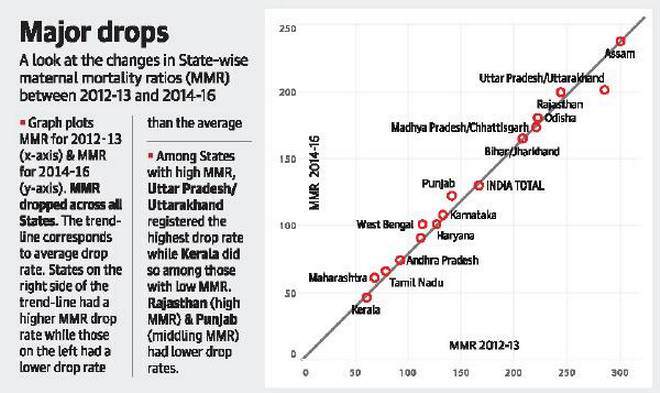The registrar general of India has released new data showing significant decline in maternal mortality ratio of the country.
What is Maternal Mortality?
According to WHO, Maternal Mortality is death of a woman while pregnant or within 42 days of termination of pregnancy, irrespective of the duration and site of the pregnancy, from any cause related to or aggravated by the pregnancy or its management but not from accidental or incidental causes.
What is MMR?
Maternal Mortality Rate is death of such women per 100,000 live births. Maternal and child mortality and morbidity are taken as important health indicators because they reflect the state of female healthcare.
Maternal Mortality Rate in India:
-
In the 2011-13 period, India’s MMR was 167. As per the recently released data, the MMR during 2014-16 period stands at 130.
-
Significant decline (246 to 188) was seen in the so called Empowered Action Group (EAG) states and Assam.
-
EAG states are those states where economic and development indicators are a particular concern.
-
Such states include Bihar, Chhattisgarh, Jharkhand, Madhya Pradesh, Odisha, Rajasthan, Uttarakhand and Uttar Pradesh.

Note: Make this type of diagram. It is easy to make and looks good.
Steps taken and their impact:
-
India has made concerted push to increase access to quality maternal health services which has doubled since 2005.
-
Proportion of institutional deliveries in public facilities has almost tripled, from 18% in 2005 to 52% in 2016 (including private facilities, institutional deliveries).
-
State-subsidised demand-side financing like Janani Shishu Suraksha Karyakram (JSSK) has largely closed urban-rural divide traditionally seen in institutional births.
-
JSSK also allows all pregnant women delivering in public health institutions free transport and no-expense delivery, including caesarian section.
-
Government has put significant emphasis on mitigating social determinants of maternal health.
-
Women in India are now more literate than ever, with 68% are now able to read and write.
-
They are also entering marriage at older age, with just 27% now wedded before age of 18.
-
These factors have enabled Indian women to better control their reproductive lives and make decisions that reflect their own interests and wants.
-
Moreover, Government also has put in substantive efforts to facilitate positive engagement between public and private health care providers.
-
Public campaigns such as Pradhan Mantri Surakshit Matritva Abhiyan have been introduced with great impact, allowing women access to antenatal check-ups, obstetric gynecologists and to track high-risk pregnancies.